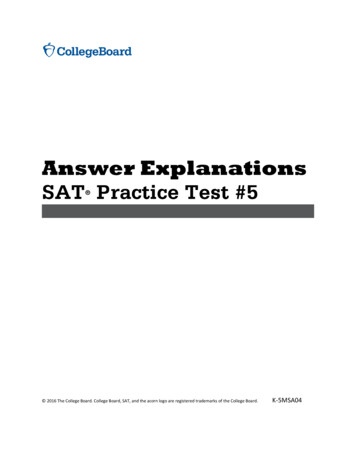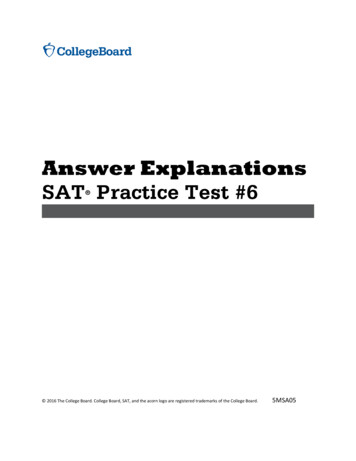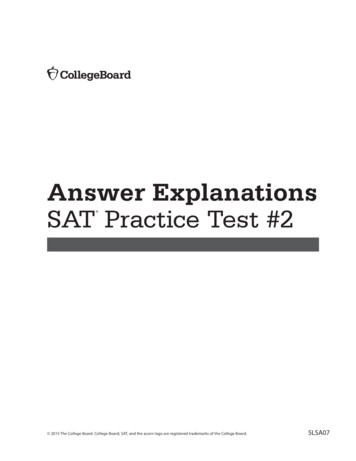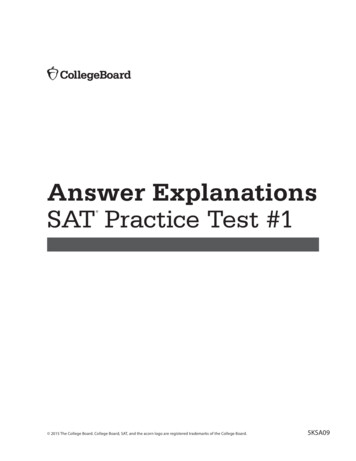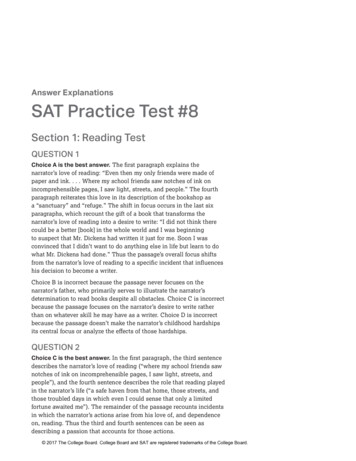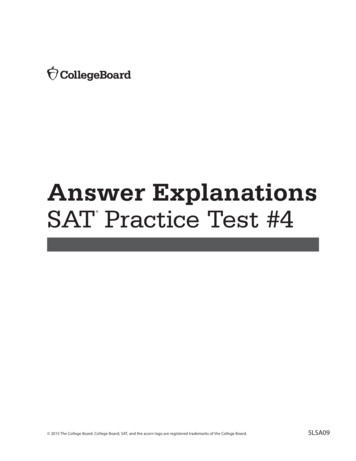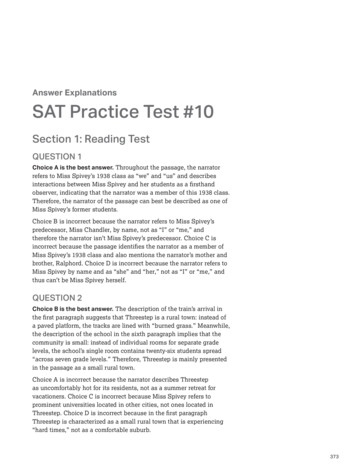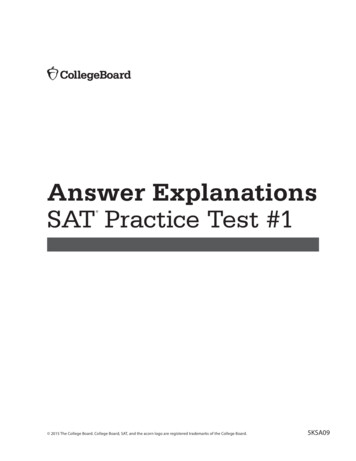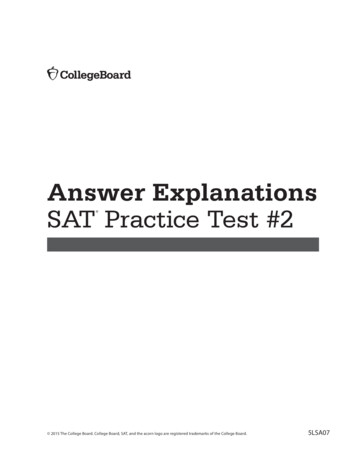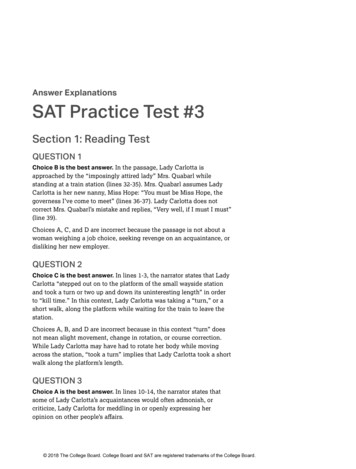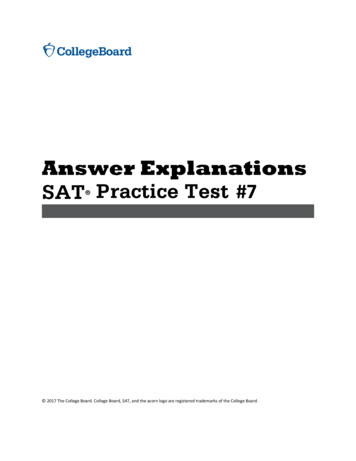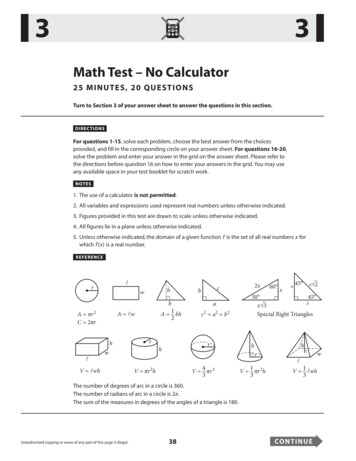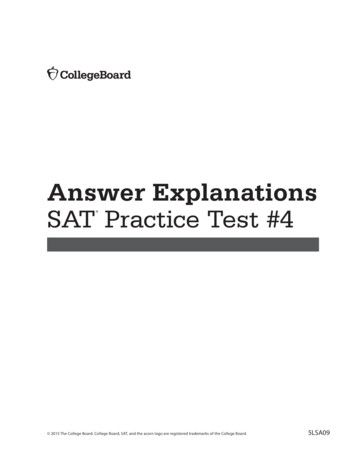
Transcription
Answer ExplanationsSAT Practice Test #4 2015 The College Board. College Board, SAT, and the acorn logo are registered trademarks of the College Board.5LSA09
QUESTION 40.Choice B is the best answer because it provides the singular nouns “writer”and “speaker” to agree with the singular pronoun “anyone.”Choices A, C, and D are incorrect because none creates pronoun-referentagreement.QUESTION 41.Choice D is the best answer because it expresses in the clearest, simplestway the idea that many game designers start out as programmers.Choices A, B, and C are incorrect because each is unnecessarily wordy andobscures meaning.QUESTION 42.Choice D is the best answer because it logically and appropriately modifiesthe phrase “collaboration skills.”Choices A, B, and C are incorrect because none appropriately describes thevalue of collaboration skills.QUESTION 43.Choice A is the best answer because it provides a logical subject for themodifying phrase “demanding and deadline driven.”Choices B, C, and D are incorrect because each creates a dangling modifier.QUESTION 44.Choice B is the best answer because sentence 5 expresses the main pointupon which the paragraph elaborates.Choices A, C, and D are incorrect because none places sentence 5 in theappropriate position to set up the details contained in the paragraph.Section 3: Math Test — No CalculatorQUESTION 1.Choice A is correct. The expression x 1 1 will equal 0 if x 1 1. Thisis true for x 2 and for x 0. For example, substituting x 2 into the expression x 1 1 and simplifying the result yields 2 1 1 1 1 1 1 0.Therefore, there is a value of x for which x 1 1 is equal to 0.Choice B is incorrect. By definition, the absolute value of any expressionis a nonnegative number. Substituting any value for x into the expression22
x 1 will yield a nonnegative number as the result. Because the sum ofa nonnegative number and a positive number is positive, x 1 1 willbe a positive number for any value of x. Therefore, x 1 1 0 for anyvalue of x. Choice C is incorrect. By definition, the absolute value of anyexpression is a nonnegative number. Substituting any value for x into theexpression 1 x will yield a nonnegative number as the result. Because thesum of a nonnegative number and a positive number is positive, 1 x 1will be a positive number for any value of x. Therefore, 1 x 1 0 forany value of x. Choice D is incorrect. By definition, the absolute value of anyexpression is a nonnegative number. Substituting any value for x into theexpression x 1 will yield a nonnegative number as the result. Because thesum of a nonnegative number and a positive number is positive, x 1 1will be a positive number for any value of x. Therefore, x 1 1 0 for anyvalue of x.QUESTION 2.3Choice A is correct. Since f(x) x b and f(6) 7, substituting 6 for x in2333f(x) x b gives f(6) (6) b 7. Then, solving the equation (6) b 722218for b gives b 7, or 9 b 7. Thus, b 7 9 2. Substituting this23value back into the original function gives f(x) x 2; therefore, one can236evaluate f( 2) by substituting 2 for x: ( 2) 2 2 3 2 5.22Choice B is incorrect as it is the value of b, not of f( 2). Choice C is incorrectas it is the value of f(2), not of f( 2). Choice D is incorrect as it is the value off(6), not of f( 2).QUESTION 3.Choice A is correct. The first equation can be rewritten as x 6y. Substituting6y for x in the second equation gives 4(y 1) 6y. The left-hand side can berewritten as 4y 4, giving 4y 4 6y. Subtracting 4y from both sides of theequation gives 4 2y, or y 2.Choices B, C, and D are incorrect and may be the result of a computationalor conceptual error when solving the system of equations.QUESTION 4.Choice B is correct. If f(x) 2x 5, then one can evaluate f( 3x) by sub-stituting 3x for every instance of x. This yields f( 3x) 2 ( 3x) 5, whichsimplifies to 6x 5.Choices A, C, and D are incorrect and may be the result of miscalculationsin the substitution or of misunderstandings of how to evaluate f( 3x).23
QUESTION 5.Choice C is correct. The expression 3(2x 1)(4x 1) can be simplifiedby first distributing the 3 to yield (6x 3)(4x 1), and then expanding toobtain 24x 2 12x 6x 3. Combining like terms gives 24x 2 18x 3.Choice A is incorrect and may be the result of performing the term-by-termmultiplication of 3(2x 1)(4x 1) and treating every term as an x-term.Choice B is incorrect and may be the result of correctly finding (6x 3)(4x 1),but then multiplying only the first terms, (6x)(4x), and the last terms, (3)(1),but not the outer or inner terms. Choice D is incorrect and may be the resultof incorrectly distributing the 3 to both terms to obtain (6x 3)(12x 3), andthen adding 3 3 and 6x 12x and incorrectly adding the exponents of x.QUESTION 6.3a b 3a b can be rewritten as Choice B is correct. The equation ,7b3a 310afrom which it follows that 1 , or 1 .b7b7bb77Choices A, C, and D are incorrect and may be the result of calculation errorsa b3in rewriting . For example, choice A may be the result of a sign7ba b aa berror in rewriting as 1.bb b bQUESTION 7.Choice D is correct. In Amelia’s training schedule, her longest run in week 16will be 26 miles and her longest run in week 4 will be 8 miles. Thus, Ameliaincreases the distance of her longest run by 18 miles over the course of12 weeks. Since Amelia increases the distance of her longest run each weekby a constant amount, the amount she increases the distance of her longest18 326 8 1.5 miles.run each week is 16 4 12 2Choices A, B, and C are incorrect because none of these training scheduleswould result in increasing Amelia’s longest run from 8 miles in week 4 to26 miles in week 16. For example, choice A is incorrect because if Ameliaincreases the distance of her longest run by 0.5 miles each week and hasher longest run of 8 miles in week 4, her longest run in week 16 would be8 0.5 12 14 miles, not 26 miles.QUESTION 8.Choice A is correct. For an equation of a line in the form y mx b, the24constant m is the slope of the line. Thus, the line represented by y 3x 4has slope 3. Lines that are parallel have the same slope. To find out whichof the given equations represents a line with the same slope as the linerepresented by y 3x 4, one can rewrite each equation in the formy mx b, that is, solve each equation for y. Choice A, 6x 2y 15, can
be rewritten as 2y 6x 15 by subtracting 6x from each side of the equa615tion. Then, dividing each side of 2y 6x 15 by 2 gives y x 2215 3x . Therefore, this line has slope 3 and is parallel to the line repre2sented by y 3x 4. (The lines are parallel, not coincident, because theyhave different y-intercepts.)Choices B, C, and D are incorrect and may be the result of common misunderstandings about which value in the equation of a line represents the slopeof the line.QUESTION 9.Choice D is correct. The question states that x a x 4 and that a 2, 2 x 4. To solve for x,so substituting 2 for a in the equation yields x2square each side of the equation, which gives ( x 2 ) ( x 4 ) 2 , or x 2 ( x 4 )2 . Then, expanding ( x 4 )2 yields x 2 x 2 8x 16, or 0 x 2 9x 18.Factoring the right-hand side gives 0 (x 3)(x 6), and so x 3 or x 6.However, for x 3, the original equation becomes 3 2 3 4, which yields1 1, which is not true. Hence, x 3 is an extraneous solution that arose fromsquaringeach side of the equation. For x 6, the original equation becomes6 2 6 4,whichyields 4 2, or 2 2. Since this is true, the solution set of x 2 x 4 is {6}. Choice A is incorrect because it includes the extraneous solution in the solution set. Choice B is incorrect and may be the result of a calculation or factoring error. Choice C is incorrect because it includes only the extraneoussolution, and not the correct solution, in the solution set.QUESTION 10.t 5t 510(t 5). Distributing the 10 over the values in the parentheses yields t 5 10t 50. Subtracting t from each side of the equation gives 5 9t 50, andthen adding 50 to each side gives 55 9t. Finally, dividing each side by 9 yields55t .9Choices A, B, and C are incorrect and may be the result of calculation errorsor using the distribution property improperly.Choice D is correct. Multiplying each side of 10 by t 5 gives t 5 QUESTION 11.Choice C is correct. Since y (2x 3)(x 9) and x 2y 5, it followsthat x 2 ( ( 2x 3 ) ( x 9 ) ) 5 4x 2 30x 54. This can be rewrittenas 4x 2 29x 54 0. Because the discriminant of this quadratic equation, 29 2 (4)( 54) 29 2 4(54), is positive, this equation has 2 distinctroots. Using each of the roots as the value of x and finding y from the equation x 2y 5 gives 2 ordered pairs (x, y) that satisfy the given system of25
equations. Since no other value of x satisfies 4x 2 29x 54 0, there areno other ordered pairs that satisfy the given system. Therefore, there are2 ordered pairs (x, y) that satisfy the given system of equations.Choices A and B are incorrect and may be the result of either a miscalculationor a conceptual error. Choice D is incorrect because a system of one quadraticequation and one linear equation cannot have infinitely many solutions.QUESTION 12.Choice C is correct. Since the price of Ken’s sandwich was x dollars, andPaul’s sandwich was 1 more, the price of Paul’s sandwich was x 1 dollars.Thus, the total cost of the sandwiches was 2x 1 dollars. Since this cost2x 1was split evenly, Ken and Paul each paid x 0.5 dollars plus a 20%2tip. After adding the 20% tip, each of them paid (x 0.5) 0.2(x 0.5) 1.2(x 0.5) 1.2x 0.6 dollars.Choices A, B, and D are incorrect. These expressions do not model the givencontext. They may be the result of errors in setting up the expression or ofcalculation errors.QUESTION 13.Choice B is correct. One can find the intersection points of the two graphsby setting the functions f(x) and g(x) equal to one another and then solvingfor x. This yields 8x 2 2 8 x 2 2. Adding 8 x 2 and 2 to each side of the1 , and thenequation gives 16 x2 4. Then dividing each side by 16 gives x 2 41 . From the graph, the valuetaking the square root of each side gives x 2of k is the x-coordinate of the point of intersection on the positive x-axis.1 .Therefore, k 2Alternatively, since ( k, 0 ) lies on the graph of both f and g, it follows thatf(k) g(k) 0. Thus, evaluating f(x) 8 x 2 2 at x k gives 0 8 k 2 2.Adding 2 to each side yields 2 8 k 2 and then dividing each side by 81 k 2 . Taking the square root of each side then gives k 1 . From thegives 421 .graph, k is positive, so k 2Choices A, C, and D are incorrect and may be the result of calculation errorsin solving for x or k.QUESTION 14.8 iChoice A is correct. To rewrite in the standard form a bi, multiply263 2i8 ithe numerator and denominator of by the conjugate, 3 2i. This gives3 2i24 16i 3i ( i)(2i)8 i 3 2i . Since i2 1, this last fraction3 2i 3 2i 3 2 (2i) 2 ()()
13i24 16i 3i 2 26 , which simplifies to 2 i.can be rewritten as139 ( 4)8 iTherefore, when is rewritten in the standard form a bi, the value3 2iof a is 2.Choices B, C, and D are incorrect and may be the result of errors in symbolic manipulation. For example, choice B could be the result of mistakenly8 18 i as i.rewriting 3 2i 3 2QUESTION 15.Choice B is correct. The given quadratic equationcan be rewritten as b b 2 4ac , to this equa2 x2 kx 4p 0. Applying the quadratic formula, 2a2 k k 32p .tion with a 2, b k, and c 4p gives the solutions 44Choices A, C, and D are incorrect and may be the result of errors in applyingthe quadratic formula.QUESTION 16.The correct answer is 9. Since the three shelves of the triangular shelf sys-tem are parallel, the three triangles in the figure are similar. Since the shelvesdivide the left side of the largest triangle in the ratio 2 to 3 to 1, the similarityratios of the triangles are as follows. Smallest to middle: 2 to 5 Smallest to largest: 2 to 6, or 1 to 3 Middle to largest: 5 to 6The height of the largest shampoo bottle that can stand upright on the middle shelf is equal to the height of the middle shelf. The height of the entiretriangular shelf system is 18 inches. This is the height of the largest triangle.The height of the middle shelf is the height of the middle triangle minusthe height of the smallest triangle. Since the similarity ratio of the middle triangle to the largest triangle is 5 to 6, the height of the middle shelf5is (18) 15 inches. Since the similarity ratio of the smallest triangle to the61 (18) 6 inches.largest triangle is 1 to 3, the height of the middle shelf is 3Therefore, the height of the middle shelf is 9 inches.QUESTION 17.3The correct answer is .6 or . The angles marked x and y are acute5angles in a right triangle. Thus, they are complementary angles. By thecomplementary angle relationship between sine and cosine, it follows thatsin(x ) cos(y ). Therefore, the cosine of y is .6. Either .6 or the equivalent3fraction may be gridded as the correct answer.527
Alternatively, since the sine of x is .6, the ratio of the side opposite the x angle to the hypotenuse is .6. The side opposite the x angle is the side adjacent to the y angle. Thus, the ratio of the side adjacent to the y angle to thehypotenuse, which is equal to th
Answer Explanations SAT . Choice B is the best answer because it provides the singular nouns “writer” and “speaker” to agree with the singular pronoun “anyone.” Choices A, C, and D are incorrect because none creates pronoun-referent agreement. QUESTION 41. Choice D is the best answer because it expresses in the clearest, simplest way the idea that many game designers start out as .
